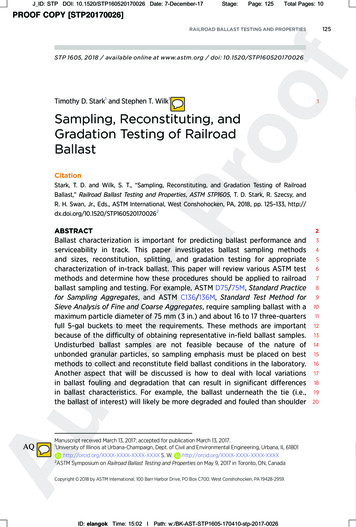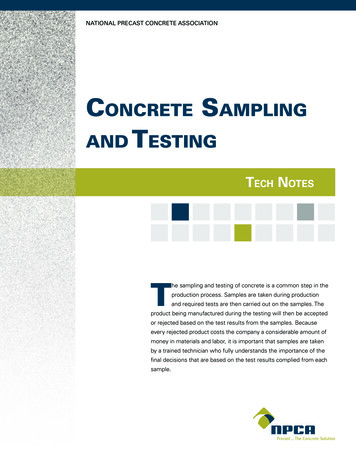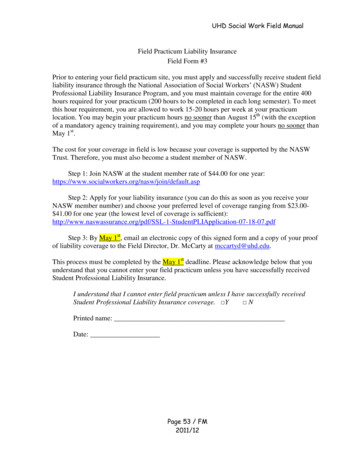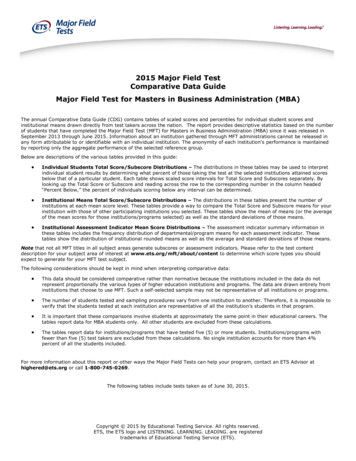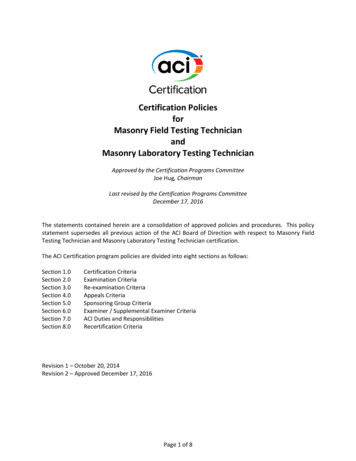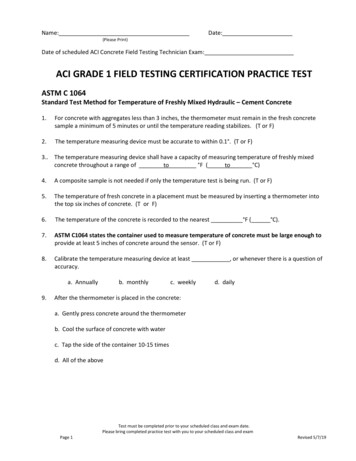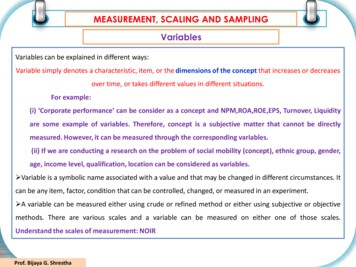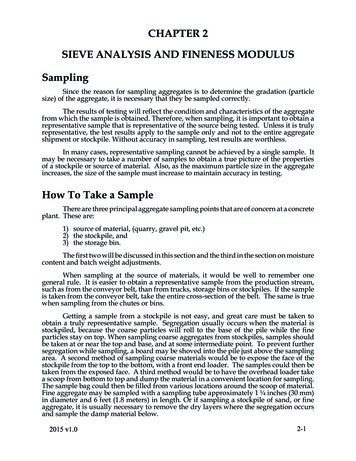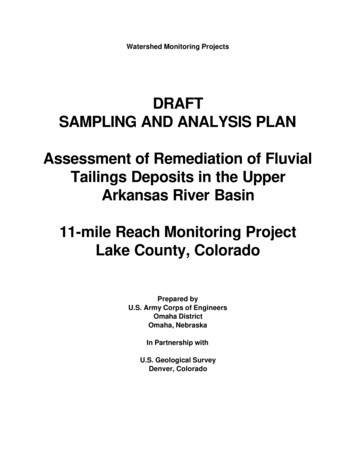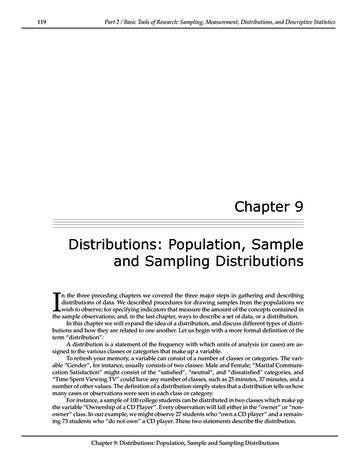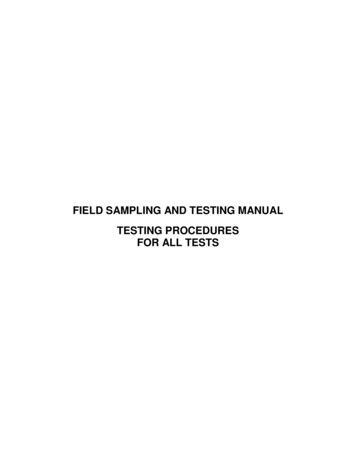
Transcription
FIELD SAMPLING AND TESTING MANUALTESTING PROCEDURESFOR ALL TESTS
Intentionally Left Blank
TESTING PROCEDURES FOR ALL TESTSTABLE OF CONTENTSND T 2Sampling Of AggregatesND T 11Materials Finer than No. 200 Sieve in Mineral Aggregates by WashingND T 23Making and Curing Concrete Test Specimens in the FieldND T 27Sieve Analysis of Fine and Coarse AggregatesND T 84Specific Gravity and Absorption of Fine AggregateND T 85Specific Gravity and Absorption of Coarse AggregateND T 87Dry Preparation of Disturbed Soil and Soil Aggregate Samples for TestND T 89Determining the Liquid Limit of SoilsND T 90Determining the Plastic Limit and Plasticity Index of SoilsND T 99/T 180 Moisture-Density Relations of SoilsND T 113Lightweight Pieces in AggregateND T 119Slump of Hydraulic Cement ConcreteND T 121Density (Unit Weight), Yield, and Air Content (Gravimetric) of ConcreteND T 141Sampling Freshly Mixed ConcreteND T 152Air Content of Freshly Mixed Concrete by the Pressure MethodND T 166Bulk Specific Gravity of Compacted Asphalt Mixtures Using SaturatedSurface-Dry SpecimensND T 176Plastic Fines in Graded Aggregates and Soils by Use of the SandEquivalent TestND T 191Density of Soil In-Place by the Sand-Cone MethodND T 209Theoretical Maximum Specific Gravity and Density of Hot Mix Asphalt3/13/2019 RevisedProceduresPage 1 of 2
ND T 217Determination of Moisture in Soils by Means of a Calcium Carbide GasPressure Moisture Tester (Speedy)ND T 224Correction for Coarse Particles in the Soil Compaction TestND T 245Resistance to Plastic Flow of Bituminous Mixtures Using MarshallApparatusND T 248Reducing Samples of Aggregate to Testing SizeND T 255Total Evaporable Moisture Content of Aggregate by DryingND T 265Laboratory Determination of Moisture Content of SoilsND T 304Uncompacted Void Content of Fine AggregateND T 309Temperature of Freshly Mixed Hydraulic Cement ConcreteND T 312Preparing and Determining Density of Hot Mix Asphalt (HMA)Specimens by Means of the Superpave Gyratory CompactorND T 318Water Content of Freshly Mixed Concrete Using Microwave OvenDryingND D 2167Density and Unit Weight of Soil in Place by the Rubber-Balloon MethodND D 4643Microwave Method of Drying SoilsND D 4791Flat Particles, Elongated Particles, or Flat and Elongated Particles inCoarse AggregateNDDOT 1Sampling of Bituminous MaterialsNDDOT 2DELETED 3/13/2019NDDOT 3Shale, Iron Oxide Particles, Lignite and Other Coal, Soft Particles,Thin or Elongated PiecesNDDOT 4Percentage of Fractured Particles in Coarse AggregateNDDOT 5Sampling and Splitting Field Verification Hot Mix Asphalt (HMA)SamplesNDDOT 6Settlement Test for Liquid Membrane Curing Compound3/13/2019 RevisedProceduresPage 2 of 2
ND T 2ND T 2 – SAMPLING OF AGGREGATESSCOPEThis test defines the procedures used to obtain samples that will show the natureand condition of the materials which they represent.For equipment specification details consult the current AASHTO edition.REFERENCED DOCUMENTSAASHTO T 2, Sampling of AggregatesND T 248 and AASHTO T 248, Reducing Samples of Aggregate to Testing SizeTERMINOLOGYMaximum Size of Aggregate – the smallest sieve opening through which theentire amount of aggregate is required to pass.Nominal Maximum Size – the smallest sieve opening through which the entireamount of the aggregate is permitted to pass.Maximum Aggregate Size (SuperPave) – one size larger than the nominalmaximum aggregate size.Nominal Maximum Aggregate Size (SuperPave) – one size larger than the firstsieve that retains more than 10% aggregate.APPARATUSContainers, pails or bagsShovelScoop or spoonBrushSampling tubesTEST SPECIMENThe sample size is based on the type and number of tests to be performed. Thefollowing table gives the approximate sample size required for differentaggregate sizes.3/13/2019 RevisedND T 2Page 1 of 4
ND T 2SIZE OF SAMPLENominal Size ofApproximate Minimum Mass ofAggregateAField SamplesBFine AggregateNo. 8 (2.36 mm)25 lbs (10 kg)No. 4 (4.74 mm)25 lbs (10 kg)Coarse Aggregate3/8" (9.5 mm)8 lbs ( 4 kg)1/2" (12.5 mm)16 lbs ( 8 kg)5/8" (16.0 mm)30 lbs (15 kg)3/4" (19.0 mm)44 lbs (20 kg)1" (25.0 mm)88 lbs (40 kg)1½" (37.5 mm)132 lbs (60 kg)A For processed aggregate, use the nominal maximum sizeas indicated by the appropriate specification or description.If the specification or description does not indicate anominal maximum size, use the maximum size (sieveindicating 100% passing).BFor combined coarse and fine aggregates, e.g., base orsubbase, the minimum weight shall be the coarseaggregate minimums plus 25 lbs (10 kg).PROCEDUREWhen practicable, samples shall be obtained from the finished product. Samplingrequires a number of individual samples that are combined to make a compositesample. Reduce the sample to the required size by quartering or splitting inaccordance with ND T 248.3/13/2019 RevisedND T 2Page 2 of 4
ND T 2 SAMPLING FROM ROADWAY:When sampling from the roadway material or in-place, take samples from at leastthree approximately equal increments across the roadway. Obtain samples fromthe full depth of the course. Take care to avoid including material from theunderlying subgrade or base course. Combine the samples to form a compositesample. SAMPLING FROM A FLOWING AGGREGATE STREAM:Obtain at least three approximately equal increments and combine to form therequired size sample. Collect the samples in a pan or by use of a samplingdevice. Take the samples from the entire cross section as it is being discharged.The receptacle should be of sufficient size to intercept the entire stream and holdthe material without overflowing. SAMPLING FROM A WINDROW:Sample the windrow by removing the top one-foot of material and obtain part ofthe sample from each side. Avoid the segregated coarser material at the bottomof the side slope. Combine three samples to form a composite sample. SAMPLING FROM A CONVEYOR BELT:Obtain at least three approximately equal increments and combine to form therequired size sample. Stop the conveyor belt and clean off a section of materialfrom the belt. Insert a template that conforms to the shape of the belt. Carefullyremove all the material from the template. Use a scoop to remove as much ofthe material as possible. A brush and dustpan may be used to remove the finematerial. Make sure to include all of the fine material. Space the three samplesapart. SAMPLING FROM A STOCKPILE:Segregation often occurs when materials are stockpiled; therefore, it is difficult toensure unbiased samples from stockpiles. For coarse or mixed coarse and fineaggregate, make every effort to enlist the services of power equipment todevelop a separate, small sampling pile composed of material from various levelsand locations in the main pile. Combine several increments to compose thesample.Where power equipment is not available, combine material from at least threeincrements: the top third, middle third, and bottom third of the pile. Insert a boardvertically into the pile just above the sampling point to aid in preventing furthersegregation. Remove the outer layer, which may be segregated, and sample thematerial beneath.3/13/2019 RevisedND T 2Page 3 of 4
ND T 2An alternate sampling method is to insert a sampling tube into the pile at aminimum of five random locations to extract material to form a sample. Samplingtubes are approximately 1¼" (minimum) in diameter by 6' (minimum) in length SAMPLING FROM A TRUCK:For coarse aggregate or composite of coarse and fine aggregate, sample fromtrucks. Take samples from a minimum of three trenches. Dig trenches acrossthe truck box at points on the surface that appear to be representative of thematerial. Make the trench bottom approximately level, at least one-foot wide andone-foot below the surface of the aggregate. Take equal portions of material bypushing the shovel downward into the material in the bottom of the trench atthree equally spaced locations. Do not scrape the material horizontally.Combine the nine portions (minimum) to form the combined sample from thetruck.For sampling the fine aggregate, insert a sampling tube at a minimum of fivelocations. Sampling tube should be a minimum of 1¼" in diameter by 6' inlength.NOTESIt is desirable to sample any material as near as possible to, if not at, the final inplace position. Hierarchies of preferred sampling locations are in-place, windrow,conveyor belt, flowing stream, truck box, or stockpile.3/13/2019 RevisedND T 2Page 4 of 4
2/13/2015 RevisedND T 11ND T 11 - MATERIALS FINER THAN NO. 200 (75 µm) SIEVE INMINERAL AGGREGATES BY WASHINGConduct this procedure according to ND T 11.The AASHTO standard test procedure reports the percentage of material finerthan the No. 200 sieve to the nearest 0.1%, except if the result is 10% or more,than it reports to the nearest whole number. The NDDOT modification reportsthe accuracy to the same significant digit as the specification for the class ofaggregate.Consult the current edition of AASHTO for procedure in its entirety and theequipment specification details.SCOPEThis test method determines the amount of material finer than the No. 200 sievein aggregate by washing. Procedure A shall be used unless otherwise specified.When accurate determinations of material finer than the No. 200 in fine or coarseaggregate are desired, this test method is used on the aggregate sample prior todry sieving according to ND T 27. The results of this procedure are included inthe calculations for ND T 27.REFERENCED DOCUMENTSND T 2 and AASHTO T 2, Sampling AggregatesAASHTO T 11, Materials Finer than No. 200 Sieve by WashingND T 27 and AASHTO T 27, Sieve Analysis of Fine and Coarse AggregateND T 248 and AASHTO T 248, Reducing Samples of Aggregate to Testing SizeND T 255 and AASHTO T 255, Total Evaporable Moisture Content of Aggregateby DryingAPPARATUSBalanceSieves: No. 16 and No. 200Sample splitterOvenWashing containerSpoonND T 11Page 1 of 3
2/13/2015 RevisedND T 11TEST SPECIMENObtain sample according to ND T 2. Thoroughly mix and reduce according toND T 248.Test specimen shall be a representative sample based on the following table.Nominal Maximum SizeMinimum MassNo. 4 (4.75 mm) or smaller300 g3/8" (9.5 mm)1000 g3/4" (19.0 mm)2500 g1½" (37.5 mm)5000 gThe sample size required for this test is a minimum after drying.PROCEDURERecord all information on SFN 9987 or SFN 2455. Weights are recorded to thenearest 0.1 g.Oven dry the sample according to ND T 255 at a temperature of 230 9 F(110 5 C). Weigh and record as original weight of sample.Place the sample into the washing container and add sufficient water to cover.Stir and agitate the sample with the spoon until all fines are in suspension.Slowly decant the water into the stacked No. 16 and No. 200 sieves being carefulnot to lose the coarser material of the sample.Add a second charge of water to the sample in the washing container and stir,agitate, and decant. Repeat this process until the wash water is clear.Wash any remaining material on the sieve back into the sample. Do not decantany water from the container except through a No. 200 sieve to avoid loss ofmaterial. Any remaining water should be evaporated by the drying procedure.Oven dry the sample according to ND T 255 at a temperature of 230 9 F(110 5 C). Weigh and record as weight after wash.ND T 11Page 2 of 3
2/13/2015 RevisedND T 11CALCULATIONSIf this test has been ran for the purpose of accurate determination of materialfiner than the No. 200 in fine or coarse aggregate, the results of this procedureare determined by the calculations for ND T 27 on SFN 9987.To calculate material passing the No. 200 sieve as percent of the total sample forcoarse aggregate for concrete, subtract dry weight after washing from weight oftotal sample and divide result by weight of total sample. Multiply this result by100 and record as material passing No. 200 sieve as percent of total sample.The equation is as follows:A [(B-C)/B] x 100A percent of material finer than No. 200 sieve by washingB weight of total sample before washingC weight of dry sample after washingREPORTReport the percent of material finer than the No. 200 sieve to the same significantdigit as the specification for the class of aggregate.NOTESA piece of rubber tubing may be attached to a water faucet and be used to rinsematerial from the sieves. The velocity of the water, which may be increased bypinching the tubing, should not be sufficient to cause splashing of the sampleover the sides of the sieve.CALIBRATIONA calibration check of the equipment should be performed annually as aminimum, or whenever damage or repair occurs.ND T 11Page 3 of 3
Intentionally Left Blank
2/13/2015 RevisedND T 23ND T 23 - MAKING AND CURING CONCRETE TESTSPECIMENS IN THE FIELDConduct this procedure according to ND T 23.Consult the current edition of AASHTO standard procedure in its entirety andequipment specification details.SCOPEThis method covers procedures for making, curing, and transporting cylinder orflexural beam specimens made from representative samples of fresh concreteunder field conditions.REFERENCED DOCUMENTSAASHTO T 23, Making and Curing Concrete Test Specimens in the FieldND T 141 and AASHTO T 141, Sampling Freshly Mixed ConcreteND T 309 and AASHTO T 309, Temperature of Freshly Mixed Hydraulic-CementConcreteND T 119 and AASHTO T 119, Slump of Hydraulic Cement ConcreteND T 152 and AASHTO T 152, Air Content of Freshly Mixed Concrete byPressure MethodAASHTO M 201, Mixing Rooms, Moist Cabinets, Moist Rooms, and WaterStorage Tanks Used in the Testing of Hydraulic Cements and ConcretesAPPARATUSCylinder moldsBeam moldsTamping rodsInternal vibratorMalletWood floatTrowelScoopShovelSampling and mixing receptacleCalcium hydroxide storage tankSAMPLING AND PREPARING CONCRETE SAMPLEObtain a concrete sample according to ND T 141. Obtain at least a 1-cu.ft.sample.ND T 23Page 1 of 6
2/13/2015 RevisedND T 23Transport the sample to the test specimens molding site and re-mix with a shovelto assure maximum uniformity. Prote
ND T 2 and AASHTO T 2, Sampling Aggregates AASHTO T 11, Materials Finer than No. 200 Sieve by Washing ND T 27 and AASHTO T 27, Sieve Analysis of Fine and Coarse Aggregate ND T 248 and AASHTO T 248, Reducing Samples of Aggregate to Testing Size ND T 255 and AASHTO T 255, Total Evaporable Moisture Content of Aggregate by Drying APPARATUS Balance Sieves: No. 16 and No.
